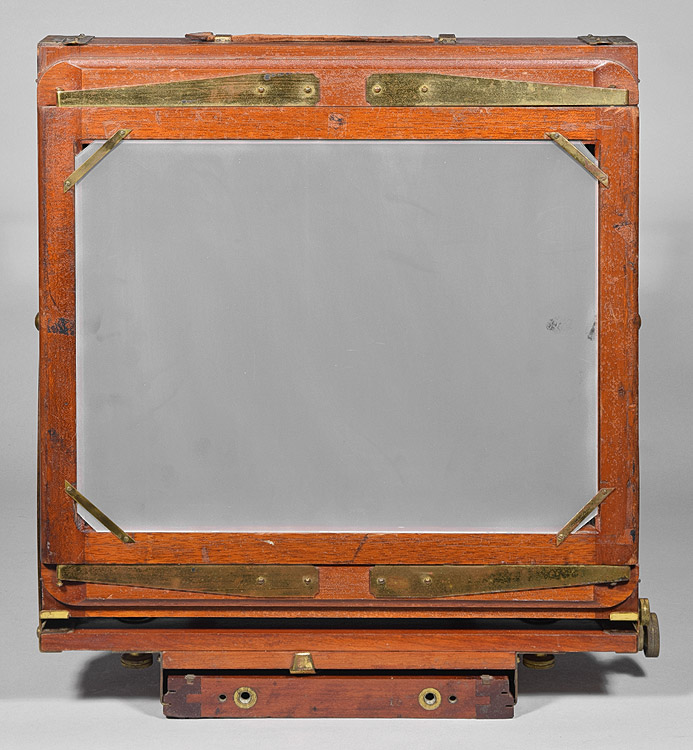Eastman Kodak Co., Rochester, NY
Eastman View Camera 11x14 Variation 2
11 x 14






Bottom

Label, lower front standard.

Date Introduced: -
; Years Manufactured:
c.1925-1930s or c.1905
Construction: front and
rear focus via rack and pinion (two gear
tracks on top of base rails); double swing; three-piece lens
board; reversing by removable back
Materials: mahogany body; cherry base;
black leatherette bellows; brass hardware
Sizes Offered: 11x14 only
Notes:
After having discarded the name Empire State in 1913, in favor of the Eastman View No. 1 (introduced in 1914 as the replacement and improvement of the Empire State). However, the Eastman Views were only made up through 8x10, and in 1915, the Premo Cameras catalog offered (hidden within the pages of the Eastman View No. 1) to make the "regular Empire State" in 11x14. This version of 11x14 only camera, presumably resembling the former Empire State Variation 3, was continued until at least 1925 (references with Empire State Variation 3). By 1927, the Empire State 11x14 was gone and the Eastman View 11x14 was undoubtedly its replacement. One reason for the name change is that the hardware changed from the crooked type rear tilt to the straight type rear tilt shown in the above engraving. This is why the Eastman View 11x14 is here considered a separate model to the Empire State 11x14, even though there is insufficient data (engravings) to confirm this. The straight-type hardware appears to be that formerly used by the Century Camera Co., as in the Century No. 1 and Century No. 2, although other details appear to derive from the former Rochester Optical Co. Empire State models, as in Empire State Variation 3.
There are two variations of the
Eastman View
Camera 11x14. The catalogs only feature
Variation 1, while
Variation 2 is slightly different but has a Century label. The
Century Camera Co. was purchased by Eastman Kodak, and Eastman View
Cameras are very similar to the view cameras made by Century.
There is a possibility that this should be referred to as a
Century Camera Co. Century View
Camera Variation 1.3 because of
those similarities.
This
camera model is advertised extensively in Kodak professional catalogs as
well as catalogs from other Kodak dealers starting about 1925 and
continuing through at least 1939. Its front standard has the same
designe as earlier Kodak view cameras, such as The Empire State No. 1,
The Empire State No. 2, and The Eastman View Camera No. 1 Variation 1.
Its rear standard forward/back swing hardware is straight, however -
identical to the hardware used in Century Camera Co. view cameras in the
early 1900s, and apparently never used on any Kodak view camera since
1903. Why did they use a 20 year-old Century design for one-size
large camera when every other view camera they had made after 1903 had a
dog-leg design, e.g., The Eastman View No. 2d? The answer can be
found the description of each camera model advertised in the Eastman
catalogs, specifically, the sizes made. Of all the view camera
models made by EKC, none was offered in a size larger than 8x10.
But the Century View Camera No. 1 did offer an 11x14 size. Eastman
must have inherited, when they bought the Century Camera Co., either a
supply of already made 11x14-sized swing hardware, or the dies and
instructions to make the parts. The engineering of part thickness
and size had already been proven - why re-engineer a slightly different
part.
This
camera does not seem to be illustrated in any Century Camera Co. catalogs
nor any Eastman Kodak Co. catalogs. It is identical to the
Eastman View Camera 11x14 Variation 1 except for the hardware that
supports the front standard, in that the supports on this camera wrap
around the front of the standard legs, whereas the supports on
Variation
1 do not wrap around. Given that it has a label that reads
Century, and furthermore is identical to the Century Camera Co. labels
used 1901-1903, and there are no Eastman stamps or other markings, this
camera could indeed be from that era, rather than the era of a
Variation
1 (i.e., no earlier than c.1925). On the other hand,
Variation 2
has a front rise featuring a rack and pinion and a thumbscrew attached
behind the lens board - just like the front end of
Variation 1, so there
is a good chance that it is from the same time period as
Variation 1.
In that case, why the Century label?
References:
